Vegetation Indices NDVI and DVI
Application: Agriculture
BLOG – Joe ZamudioPrecision agriculture is a fast-growing application for UAVs. For this, cameras and multispectral sensors that can capture infrared light as well as visible are used to monitor the health or vigor of crops. Various band-to-band ratios or differences using these two wavelengths are used to produce information products that can be used for precision agriculture. One of the most commonly used vegetation indices is the Normalized Difference Vegetation Index (NDVI) which is shown below.

This index is a measure of the difference between near-infrared light and red light reflected from plants. The difference is normalized by dividing it by the sum of the two wavelengths. This normalization allows us to compare results from different collections at different times or in different areas.
The basis for this index is the fact that those two wavelengths (red and near-infrared) are affected by two important vegetation components pigments (specifically chlorophyll) and leaf structure. Healthy plants reflect little red light because chlorophyll absorbs light at that wavelength (chlorophyll also absorbs blue wavelengths). And healthy plants have high reflectance in the near-infrared because a healthy leaf structure strongly reflects near-infrared wavelengths. The figure below shows these characteristics:
.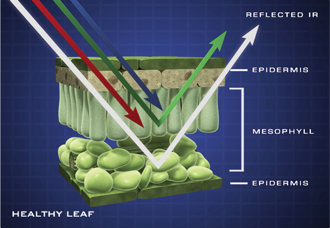
image credit: Jeff Carns, NASA
Figure 1. Chlorophyll in the leaf preferentially absorbs blue and red light. Green light is reflected (that's why healthy vegetation with lots of chlorophyll is green to our eyes). A healthy leaf cellular structure strongly reflects near-infrared light, more so than any other wavelength.
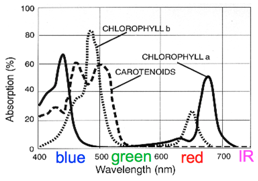
Figure 2. This graph shows what wavelengths are absorbed by selected pigments. Chlorophyll predominately absorbs blue wavelengths (400-500 nm) and red (600-700 nm). Note that carotenoids absorb blue light as well as some green.
The figure below shows how plant reflectance varies with wavelength. Reflectance spectra from two plants are shown, one plant is healthy and vigorous, the other is less so. Absorption of blue and red light by chlorophyll and other pigments keep the reflectance in the visible portion of the spectrum (400 700 nm) low. Note how much brighter plants are in the near-infrared. As mentioned above this is due to a leaf structure that preferentially reflects near-infrared wavelengths.
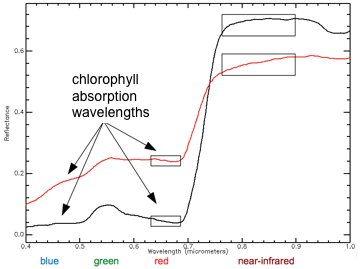
Figure 3. Reflectance spectra of healthy, vigorous vegetation (black) and less vigorous or less healthy vegetation (red). Healthier plants with more chlorophyll have lower reflectance in blue and red wavelengths. Also, healthier plants have a more robust leaf structure which results in higher near-infrared reflectance. The boxes covering sections of red and near-infrared light are typically the wavelengths that satellites (specifically Landsat TM) use in calculating NDVI. Note: The units on the x-axis in this plot are micrometers, those in figure 2 are nanometers.

Figure 4. NDVI from a late fall collection in Colorado. Green is healthy vegetation, yellow and red are increasingly less vigorous.
Currently, many farmers are using modified cameras or GoPros to produce a simple Difference Vegetation Index (DVI). Vegetation indices from these modified cameras typically use the difference between near-infrared wavelengths and either blue or green. There is no normalization of the DVI index so values from one collection cannot be compared to another. A DVI can give a general idea on the health of vegetation as any visible light wavelength is not reflected nearly as much as near-infrared. However, using either of these two wavelengths is less accurate than the classic NDVI. If blue light is used, farmers should be aware that this wavelength is strongly affected by scattered light. Blue light is more efficiently scattered in our atmosphere and scattered light adds to the signal that we get from plant reflectance in that wavelength. Efforts to monitor plant health are more accurate if we can focus focus solely on plant reflectance, so adding scattered light to plant reflectance is not optimal. Also, note that in figure 2, carotenoids also absorb blue light, and it is chlorophyll concentration rather than carotenoids that is most closely related to plant health. Using green light is also not optimal because that wavelength it is not affected at all by chlorophyll absorption. The more accurate index for plant health uses the near-infrared, which is affected by leaf structure, and red, which is affected by chlorophyll. Cameras versus multispectral sensors

From left to right: Sony a5000, GoPro Hero, and MicaSense RedEdge multispectral sensor.
Figure 5. Cameras and sensors used for agriculture. Farmers are typically using either a modified camera or a multispectral sensor to evaluate the health of their crops.
Modified cameras typically exchange a near-infrared blocking filter for a filter that blocks either blue and green, or green and red. The low cost of cameras and GoPros is attractive for many folks. However, as with most everything, you get what you pay for and there are a couple of drawbacks when using modified cameras. One thing is that the sensors on these cameras are sensitive to fairly broad wavelength ranges. The figure below shows that the wavelength ranges for blue, green, and red sensors typically overlap considerably. Detectors in a multispectral sensor are sensitive to a much narrower wavelength range.
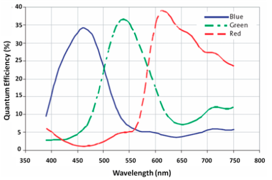
Figure 6. Response functions for red, green, and blue sensors in a commercial camera. Note the broad overlap of bands.
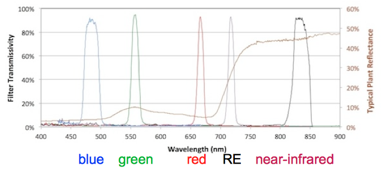
Figure 7. Response functions for a multispectral sensor (MicaSense RedEdge). This sensor has five narrow bands. One each in blue, green, red, and near-infrared wavelengths. In addition, it has a band in the vegetation “red edge” (RE) which is between red and near-infrared. The narrow bands of this sensor results in less mixing of signals from different plant components. A typical plant reflectance spectrum is also shown in this plot. Note its relationship with the five bands of the RedEdge sensor.
In theory, vegetation indices from a modified camera wouldn't have the range of index values that a narrow-band multispectral sensor would provide. Following this, a multispectral sensor with narrow bands should be able to detect plant health issues earlier than a modified camera. So should farmers not use modified cameras to monitor crops? Not necessarily. Modified cameras are a low-cost solution that may be adequate in many cases. However, farmers should know that indices from these cameras are relative, and comparing indices from one field to another, or one collection to another is not recommended. In order to compare indices from one collection to another, the sensor has to be calibrated, which involves removing the effects of scattered light, camera sensitivities, etc. The calibration of sensors is a topic that will be addressed in a future blog.
For questions or comments, please contact me zamudio@uasusa.com